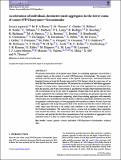Por favor, use este identificador para citar o enlazar a este item:
http://hdl.handle.net/10261/150111COMPARTIR / EXPORTAR:
 SHARE SHARE
 CORE
BASE CORE
BASE
|
|
| Visualizar otros formatos: MARC | Dublin Core | RDF | ORE | MODS | METS | DIDL | DATACITE | |

| Título: | Acceleration of individual, decimetre-sized aggregates in the lower coma of comet 67P/Churyumov-Gerasimenko |
Autor: | Agarwal, J.; Rodrigo Montero, Rafael CSIC ORCID; Gutiérrez, Pedro J. CSIC ORCID; Lara, Luisa María CSIC ORCID; López-Moreno, José Juan CSIC ORCID ; Thomas, N. | Palabras clave: | Zodiacal dust Comets: general Comets: individual: 67P/Churyumov-Gerasimenko |
Fecha de publicación: | 2016 | Editor: | Blackwell Publishing | Citación: | Monthly Notices of the Royal Astronomical Society 462: S78- S88 (2016) | Resumen: | We present observations of decimetre-sized, likely ice-containing aggregates ejected from a confined region on the surface of comet 67P/Churyumov-Gerasimenko. The images were obtained with the narrow angle camera of the Optical, Spectroscopic, and Infrared Remote Imaging System on board the Rosetta spacecraft in 2016 January when the comet was at 2 au from the Sun outbound from perihelion.We measure the acceleration of individual aggregates through a 2 h image series. Approximately 50 per cent of the aggregates are accelerated away from the nucleus, and 50 per cent towards it, and likewise towards either horizontal direction. The accelerations are up to one order of magnitude stronger than local gravity, and are most simply explained by the combined effect of gas drag accelerating all aggregates upwards, and the recoil force from asymmetric outgassing, either from rotating aggregates with randomly oriented spin axes and sufficient thermal inertia to shift the temperature maximum away from an aggregate's subsolar region, or from aggregates with variable ice content. At least 10 per cent of the aggregates will escape the gravity field of the nucleus and feed the comet's debris trail, while others may fall back to the surface and contribute to the deposits covering parts of the Northern hemisphere. The rocket force plays a crucial role in pushing these aggregates back towards the surface. Our observations show the future back fall material in the process of ejection, and provide the first direct measurement of the acceleration of aggregates in the innermost coma (<2 km) of a comet, where gas drag is still significant. © 2016 The Authors | URI: | http://hdl.handle.net/10261/150111 | DOI: | 10.1093/mnras/stw2179 | Identificadores: | doi: 10.1093/mnras/stw2179 issn: 0035-8711 |
| Aparece en las colecciones: | (IAA) Artículos (CAB) Artículos |
Ficheros en este ítem:
| Fichero | Descripción | Tamaño | Formato | |
|---|---|---|---|---|
| IAA_2016_MNRASstw2179.pdf | 4,42 MB | Adobe PDF |  Visualizar/Abrir |
CORE Recommender
SCOPUSTM
Citations
55
checked on 20-abr-2024
WEB OF SCIENCETM
Citations
51
checked on 29-feb-2024
Page view(s)
274
checked on 23-abr-2024
Download(s)
325
checked on 23-abr-2024
Google ScholarTM
Check
Altmetric
Altmetric
NOTA: Los ítems de Digital.CSIC están protegidos por copyright, con todos los derechos reservados, a menos que se indique lo contrario.
